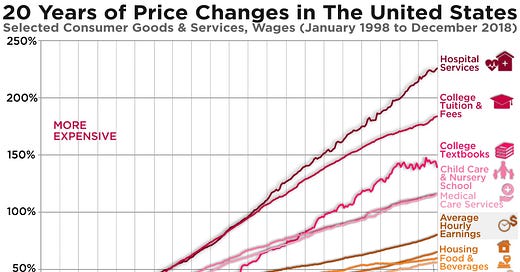Please stop overusing Baumol’s cost disease
It can’t explain things becoming less affordable, only shifts in spending
Baumol’s cost disease is probably the most overused meme amongst Matt Yglesian liberals. It gets trotted out as an all-purpose explanation of why costs are high, but it is generally used entirely wrongly. It changes the relative costs of products, but cannot make them unaffordable. It is a by-product of economic growth, not a loss. If certain services are becoming unaffordable, that is due to real decreases in productivity. College, healthcare, and so on are not doomed to unaffordability.
i. So what is it
Baumol’s cost disease explains why wages rise, even in unproductive sectors. He used the example of string players in a quartet, who have experienced no rise in productivity ever, while their wages have steadily risen. The cost of hiring a musician must exceed what they could earn doing something else. As productivity, and thus wages, has risen in other sectors, so must wages in the stagnant sectors, if you still wish to buy it.
You’ve no doubt seen this chart, or others like it, if you’ve been on twitter a while. One must use some caution in interpreting all such inflation adjusted figures, by the way. They adjust for quality when making assessments of inflation, and this adjustment for quality is naturally fraught. CPI tends to overstate inflation as well, because its consumption basket stays the same longer. (PCE, which the Fed uses, changes its consumption basket more often. The point is that as prices change, people do not simply buy the same product — they substitute. A rise in the price of apples would lead people to switch to oranges, not consume the same amount forever). Nevertheless, labor intensive jobs such as healthcare have risen in price far more than manufactured goods, which fits the story. (The figures on college appear to be wrong, though — they take the sticker price of college, which fewer and fewer people pay, thus exaggerating the cost of college).
If it is Baumol’s cost disease which is responsible for the increase in price, however, the changes in price will not make it one bit more unaffordable. It can rise only as a consequence of productivity growth elsewhere. It would simply consume a greater percentage of income, but as our income has risen, we’d still have more left over. We should consider the possibility that we have simply had negative productivity growth in healthcare or education. They are both largely state-run here in the United States — perhaps they would be more efficient entirely privately run.




Not entirely true. It is possible that the sectors of growth were not in you initial consumption bundle, or that you are not in a sector that sees income growth.